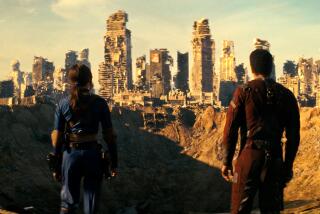Re-imagining Vancouver for ‘Caprica’
- Share via
As the location scouts for Syfy’s new series “Caprica,” Anand Kanna and Scott Firth are charged with an unusual task: to imagine Vancouver, Canada, as the Earth-like planet attacked in the 2003 pilot miniseries of “Battlestar Galactica.”
“Vancouver is a very modern city -- lots of sea-foam glass and steel and high-rises,” Firth said. “And that’s the scope of what the planet Caprica is. It’s a forward-thinking society and very modern.”
FOR THE RECORD:
Vancouver architect: In the Jan. 24 Working Hollywood column, Scott Firth was quoted as saying that architect Arthur Erickson designed the Vancouver Public Library. The library was actually designed by a team of three architects —Moshe Safdie, Richard Archambault and Barry Downs.
Before Kanna and Firth were scouring the streets of Vancouver for traces of a mythological planet, Firth was working as a real estate property administrator when he moved to Vancouver from his hometown of Toronto in 1997.
“My career prior to this wasn’t creative, and I found that’s what I needed in my job description,” he said.
A Vancouver native who attended film school at Columbia Academy, Kanna grew up making claymation models and playing with his father’s collection of old movie cameras. He enjoys scouting for its “autonomy. You have a deadline, and you’re not under someone’s thumb all the time.”
In 2003, the two met during the shoot of “Scary Movie 3.” In addition to “Caprica,” they’ve collaborated on projects including 2006’s “Scary Movie 4” and the CW’s “Reaper.”
“I remember as a kid looking at all these great buildings and going, ‘Wow,’ ” Firth said. “Now, I get to go out and find and show them, and I can hear someone else say, ‘Wow.’ ”
Grand designs: Caprica City is fictional, but it was largely designed by a real Vancouver architect. “Arthur Erickson buildings totally suit the style of the show,” Firth said. “He’s one of our favorite Vancouver architects, and you’ll see quite a few of his buildings in ‘Caprica.’ He did some buildings at the University of British Columbia and the Vancouver Public Library. They’re quite striking. They’re really sexy buildings.”
Neighborhood watch: “We used different parts of the city for different challenges,” Kanna explained. “In Vancouver, there’s an area called Coal Harbour, which is very modern. That was perfect for establishing Caprica City itself, the steel and glass look of downtown Caprica and its really modern-looking buildings.” Added Firth, “And then there’s another area of town in the series, and it’s called Little Tauron, which is a little bit backwards. It’s more of the run-down, ‘40s feel. So we would go to Chinatown for that.”
City limits: At any given time, parts of Vancouver appear on a municipal “hot list,” published quarterly. “We usually get a list from the city of locations where it’s dicey to move into,” Kanna said. “It’s a list of sensitive areas that have had a lot of filming, and it’s to give everybody a bit of a rest from having a film crew in their neighborhood. And a lot of the stuff on the hot list is construction -- not to film on a road that has a big pit on it with no water main in there. So the hot list is there just as a guideline, but the city works with us, and everything ends up working out fine in the end.”
Place holders: Since the “Caprica” writers cast their imaginations far beyond Vancouver’s brick-and-mortar reality, the location scouts follow suit. “You have to be pretty creative in a lot of ways,” Firth said. “The farthest we’ve been away is about 50 kilometers from the studio, and it was a 40,000-square-foot mansion on a farm. But it was scripted as something else. A location doesn’t have to be exactly what’s in the script, as long as you can make it look like what you need, whether you have to augment it with some set decoration or a sign.
“You have to have a very broad imagination. A school is not necessarily a school. If you’re looking for an entrance to a hotel, it could be an entrance to a shopping mall. It could be an entrance to a police station. As long as you have the vision and a sign, you can make it anything.”
More to Read
The biggest entertainment stories
Get our big stories about Hollywood, film, television, music, arts, culture and more right in your inbox as soon as they publish.
You may occasionally receive promotional content from the Los Angeles Times.










